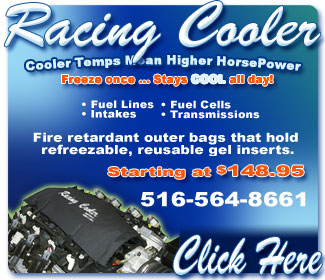|

 erry
Francis, vice president of sales at Mickey Thompson
Performance Tires and Wheels, has a three-word
answer to our question, Why should I run my
slicks with tubes inside? erry
Francis, vice president of sales at Mickey Thompson
Performance Tires and Wheels, has a three-word
answer to our question, Why should I run my
slicks with tubes inside?
"Consistency and safety," he says. And therein lies an answer to a question that is almost guaranteed to start a heated argument inside any car trailer, beer bar, racetrack grandstand or anywhere else that bracket racers gather to bench-race.
There are more opinions about whether to tube
or not to tube than there are '69 Camaro Super
Pro bracket cars out on a Saturday night. On
one side are the no-tube contingent who will
tell you that they have never raced with tubes
in their slicks and they only use a pound or
two of air each week, max. Plus, they add, a
tube is weight, and they're out to save as much
weight as they can. "Heck, when I race I don't
even eat, because I'm afraid the weight of a
hamburger and a Coke might slow me down a few
thousandths."
Then there are the guys who run tubes because they were told to. Besides, they say, a tube doesn't cost that much money. "I can go down to my local John Deere tractor store and pick up a good one for $10 or so. Works just as good as those high-dollar ones the slick makers want me to buy."
Both sides, Jerry Francis says, are wrong about their approach to tubes in drag racing.
Let's let him address the first equation first: A racer doesn't really need a racing tube for his slick.
You need a tube -- what kind we'll address later in this story -- because a
tubeless slick will leak air. "Any brand of
race tire is not guaranteed to hold air. They
can and will leak air. The carcass of the tire,
to make it hold air, has to have an extra piece
of rubber molded
ADVERTISEMENT
 |
|
into
the tire, and a racer does not want that rubber
molded into the tire, because it affects the
performance of the tire," Francis says. "The
type of rubber that would be molded in to make
it hold air is not going to aid the performance
of the tire. And it's going to add to the cost.
But that's irrelevant, because so is the tube."
So a racing tire without a tube is going to
leak. And any leakage at all will affect the
performance of the tire. When a tire is run
at too low an air pressure -- due to air leakage
or otherwise -- the carcass of the tire builds
heat to excessive levels. And heat is what destroys
a tire. "There is no rule of thumb on how many
runs you'll get out of a tire. It will just
affect the life of a tire. There are inconsistencies
on the leakage, there are inconsistencies in
the effect, and inconsistency of any kind is
the total enemy of a bracket racer. Consistency
is the whole game, the goal of a bracket racer,"
Francis said.

|